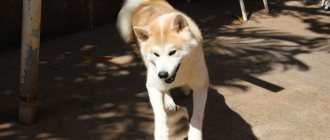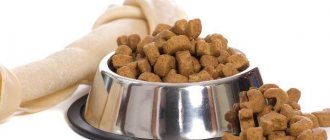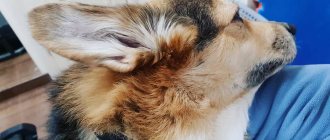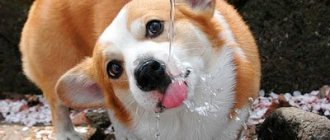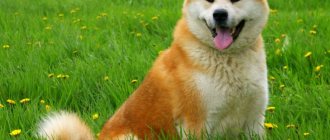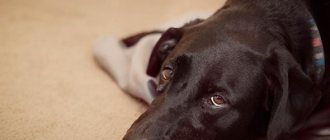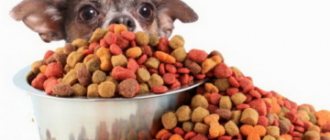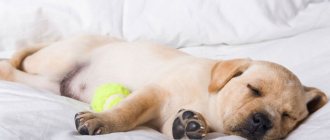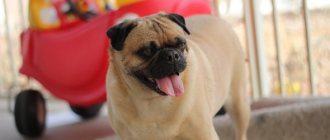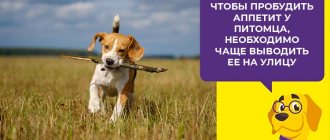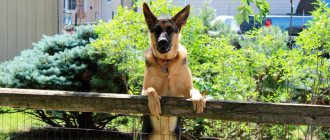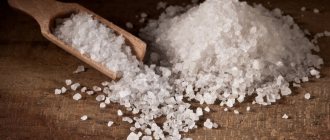Diet features
Smart and beautiful dogs are very popular not only in Japan, but also in Europe.
Many people love them for their loyalty, good manners, intelligence and external grace. Playful as children and reserved as adults, they are always happy to have an owner and play with children. Well-mannered, neat, affectionate and loving dogs will always protect the owner and their family, and their devotion is the highest level of loyalty: you can see this by watching the film “Hachiko”. Raising such a friend is not easy; he needs attention, affection, love and friendship. It is proper education, care and a balanced diet that will make your pet truly beautiful and happy.
The origin of the breed took place in Japan, and it is there that a large number of animals are concentrated. Brought up in the traditions of the samurai, dogs are accustomed to their regime and diet, which means they need to be fed accordingly.
Basic diet:
- Boiled rice;
- Seafood;
- Fish - sea, river is not recommended;
- Sea kale, seaweed;
- Vegetables and fruits;
- Lean veal;
- Meat of wild animals: elk, deer, roe deer;
- Low-fat cottage cheese.
When purchasing a dog, first of all, read this list, because your four-legged friend may be allergic to common foods.
One of the main characteristics of the Akita Inu is its high tendency to food allergies. Even food that is well suited to other breeds can lead to poisoning. In Japan, Akitas have been fed a diet of fish, rice, vegetables, seaweed salads and seafood for centuries. The higher the percentage of “Japanese blood” a puppy has, the more its digestive system is focused on such a diet. Therefore, you need to feed your Akita Inu fish, rice with vegetables and a small amount of lean meat.
The needs of a dog's body change as it grows and develops. The health and well-being of your pet depends on a properly selected diet.
Up to two months
In the first weeks after birth, the puppy feeds on mother's milk, which contains all the necessary nutrients. At this age, Akita Inu puppies need to be fed about 6 times a day: at 7:00, 10:00, 13:00, 16:00, 19:00, 22:00. If your pet came to you before the age of two months, you can use special industrial milk. Then complementary foods are gradually introduced into the diet.
At two months
At this age, small Akita Inus are usually “weaned.” Puppies can have a hard time being separated from their mother. The first two days of being in a new place they whine. Many owners try to relieve anxiety with food, and as a result, Akitas experience the first food poisoning in their lives. To avoid this, ask the breeder in advance what kind of food the puppy ate with its parents.
Use puppy food. It can be finely crushed and dissolved in special milk for weaning. The volume should be such that the dog is full. Continue feeding 5-6 times a day at the same time. Gradually, low-fat calcined cottage cheese, sea fish, and finely chopped boiled veal are introduced into the diet. Once a week, be sure to give a boiled egg.
It is very convenient to use ready-made food. Natural food should only be freshly prepared and warm (not cold, not hot). If within 20 minutes the puppy has not eaten the food offered, remove the bowl and do not offer other food until the next feeding.
At three months
At this age, the dog grows very quickly. Due to increased activity, four meals a day and water consumption should correspond to the daily diet of an adult dog. At the same time, the quality of food should change. The puppy is given more fish and meat than dairy products. To make the food more dense, small fish is added to the soaked food, half mixed with rice porridge.
This food is more suitable for the needs of Akita Inu than market dog food. Pay attention to your pet's appetite and needs, as well as the condition of its feces, skin, fur and muscles.
Meals are switched to three meals a day: at 7:00, 12:00, 17:00 and 22:00. A healthy Akita puppy should not be overly thin or overweight. Do not feed your pet; make sure that its sides do not “swell” after a meal. If the food remains in the bowl, you can reduce the portion by half until the Akita learns to eat all the food offered. And on the contrary: if the baby licks the bowl for a long time, it means there is not enough food and it should be added.
Never give your puppy game bones, poultry, sausage, pork, ham, fatty cheeses, bread, pasta and raw river fish. Also avoid legumes, sweets, potatoes and other foods that your dog doesn’t need. When feeding ready-made industrial formulas, your pet does not need additional mineral and vitamin complexes.
READ Calcined cottage cheese for puppies
After six months
Energy for normal development requires less and less energy, mainly the skeleton develops. Therefore, the diet should no longer be so high in calories. If you continue the same feeding regimen, your pet will quickly gain excess weight and the bones will begin to deform. It is better for the puppy to be thin.
At the age of 6-12 months, the Akita is transferred from Pappy food (for puppies) to Junior. Gradually they begin to add adult formulas to the diet. Vegetables can be grated, meat can be cut into larger pieces. Cottage cheese and fermented milk products should only be low-fat.
Adult dogs
The diet of a mature Akita does not change significantly. Gradually the dog is transferred to two meals a day. The main amount of food should come in the morning. It happens that with low loads and a sedentary lifestyle, Akitas eat once every two days.
Old age
The first signs of a dog's impending old age are:
- graying of fur (first on the face);
- deterioration of hearing and vision;
- low activity;
- irritability.
If these signs occur, you should reduce the fat and calorie content of your diet (6-9% fat, 15-20% protein), and at the same time increase the amount of fiber to 5%. Add more pureed vegetables to your food, but not cereals. Give your pet low-fat fermented milk products. You don’t have to cook fish and meat, but simply freeze them. There is no point in grinding them. If your older Akita has bad teeth, simply cut the fillets into smaller pieces.
For an aging dog, the “Light” and “Senior” formulas are suitable. When planning a feeding diet for an older Akita, listen to your veterinarian's recommendations.
American Akita: dog character, behavior
The large Japanese dog is very loyal to its owner. She singles out one person from the pack and is ready to follow him to the ends of the earth. As a rule, this person is a strong leader. This can be either a man or a woman. She becomes less attached to other family members. But the worst punishment for her is loneliness. It is absolutely contraindicated for her. Left to its own devices, the pet begins to get mischievous and its character deteriorates. The consequences of loneliness may be irreversible.
The most pronounced character traits of the American Akita:
- focused on communication with the owner;
- selfless devotion to the owner and family;
- patience and calmness in the absence of strong irritants;
- independence that needs to be channeled in the right direction.
Behavior at home
The American Akita dog breed has many feline traits in its character. She will follow her owner's heels, caress her, and won't mind crashing on the couch with him. Unless he won't purr. You will rarely hear your pet's voice. You can't call a pet a windbag. It attracts the owner's attention only when there is a real danger to him or the owner. Unless the loud-voiced relatives living nearby teach him to bark. It must be said that with pets living under one roof, a large Japanese dog can exist peacefully. But for this, the owner needs to show great patience in raising him.
Behavior on the street
This is the dominant breed. The American Akita is a dog that expects obedience from other members of the pack, and especially from strangers. Owners need to be attentive to any manifestations of aggression on its part. This is usually true outside the home. While walking, Americans love to get into fights. Males are more prone to this behavior, but there are also cases of fights between females. This always happens unexpectedly, so it is better to minimize contact between pets and other relatives.
A socialized dog is not aggressive towards strangers, which is confirmed by the characteristics of the breed. But this does not mean that you can allow people you meet to play pranks with him. The pet may perceive such games as an attack, then a conflict is inevitable. Dog handlers do not recommend that strangers look an Akita directly in the eyes, and especially bend over when doing so. The dog perceives this behavior as aggression. Experienced owners assure that the American Akita always distinguishes imaginary danger from real danger. This is a really smart dog, but it all depends on its level of socialization, so it’s not worth the risk.
Attitude towards children
The dog allows children a lot. He can play with them or calmly wait until the owner’s kids calm down and stop trying to pull his ears. But all patience may come to an end. Even such a calm and peaceful dog can harm a child. And although some manage to use her as a nanny, it is still not recommended to leave such a large dog as the American Akita alone with children. The description of the breed suggests that aggression is not typical for it. But in the heat of the game, she can drop the baby, trample on him, thereby seriously injuring him. To do this, she doesn’t even have to make any special efforts; her considerable weight will do everything for her.
Natural nutrition
Food should be light and low in calories. Excessive amounts of fats and grains (except rice) lead to skin diseases, allergies, joint problems, and problems with the liver and pancreas. The most common cause of allergies is chicken. It's not the meat itself, but the hormones and antibiotics that are so abundant in this product.
Japanese dogs are genetically predisposed to eat fish. A large amount of meat (especially industrial meat) in their diet provokes rashes and eczema. The dog may even lose its undercoat. You should not give sweets, otherwise your pet may develop diabetes. With a lack of physical activity, Akitas refuse to eat and starve for up to three days.
Summer food should be low-fat. In hot weather, provide rice, vegetables, low-fat dairy products, a boiled egg and some meat. In winter, the amount of food can be increased. Dogs need to be fed at the same time, this will set up the digestive system to work properly. The main feeding is best done in the morning. To clean your teeth, you can give some food in the evening. Remember that the Akita must have access to fresh water at any time of the day.
Basic diet
Food must be of high quality and properly selected. The diet of the “large Japanese dog” includes:
- fish (sea, pre-frozen);
- boiled rice;
- seafood;
- kelp, seaweed;
- vegetables and unsweetened fruits;
- game (elk, roe deer, deer);
- lean veal;
- low-fat cottage cheese.
The American Akita can be fed meat, cereals, and vegetables. Her diet should consist of:
- beef, lamb, horse meat;
- poultry and offal;
- buckwheat, rice, oats;
- yogurt, kefir;
- boiled and raw vegetables, berries, fruits.
Acceptable
Japanese Akita Inu can be given in moderation and with an eye to the reaction:
- lamb, rabbit, horse meat;
- offal (except liver and lung);
- cottage cheese;
- with caution - meat from industrial animals.
Digestive problems and allergies in Akitas can be caused by:
- river fish (due to the abundance of bones);
- poultry (chicken, turkey, goose);
- beef;
- sausages;
- smoked meats;
- pork and lard;
- fatty dairy products;
- corn, wheat and oats;
- confectionery;
- salty foods;
- spices;
- bones of birds and animals;
- potato;
- white bread and pasta;
- food with chemical additives.
In Russia, dogs are traditionally fed ready-made formulas or natural products. In Japan, it is customary to combine two methods of feeding, so Russian breeders also adhere to this diet. The most beneficial for Akita Inu is a combination of dry industrial food, mineral and vitamin complexes and recommended natural products. Homemade food can be replaced with canned dog food, but feeding just one thing is not recommended.
Feeding the puppies
Like any other purebred dog, it is better to buy an Akita not from an ad, but from a specialized nursery. Experienced breeders keep their pets properly, do not chase the number of puppies, and value their reputation.
It is most advisable to purchase puppies that are already 2 months old. After all, by that time they already have the necessary vaccinations (which should be indicated in the veterinary passport), and they also went through the branding procedure, receiving a puppy card.
You should immediately decide on the gender of your future pet. Girls grow up to be smaller, calmer and more loyal. Large boys are more likely to show arrogance and stubbornness and are more difficult to train.
The character of American Akita puppies can only be assessed from the words of the breeder, based on the genetics and behavioral characteristics of the parents. After all, kids are all active, emotional and energetic.
READ Californian breed rabbits maintenance and feeding
If in the future the owner plans to exhibit his pet, then it is necessary to inspect the puppy’s exterior for compliance with the breed standard. In addition, the baby must be healthy, well-groomed and not have an unpleasant odor.
The cost of representatives of this breed varies from 20 to 50 thousand rubles, and even more. The price depends on the puppy's pedigree and compliance with the standard.
A dog can live both in an apartment and on the street. In the first case, it is imperative to provide the dog with regular long walks. For outdoor keeping, you need to build a spacious enclosure, and if you let him out for a walk in the yard, fence it off with a high fence for the safety of your neighbors.
The dog acclimatizes to different temperature conditions. Wool provides reliable protection from any frost. True, dogs don’t really like heat.
Caring for a dog is not too difficult. It is necessary to accustom oneself to all procedures from an early age, while American Akita puppies are small.
- Brush the coat once a week, when shedding - every day, maybe several times. Akitas shed very intensively, so in spring and autumn you need to carefully monitor the cleaning of lost hair.
- Bathe your dog once every 3-4 months. If it gets very dirty, wipe it with a damp cloth.
- Clean ears, teeth and eyes as they become dirty.
- Walk your dog regularly every day for at least 2 hours.
The American Akita needs to be fed twice a day, puppies - 3 or 4 times. First, the baby must be given the food he received from the breeder. In six months you can switch to other options.
You can buy ready-made super-premium or premium food, saving time if you are not able to monitor your dog’s diet yourself.
From the day the puppy is purchased, all responsibility for its health falls on the owner. To ensure that your pet does not suffer from indigestion and grows healthy, create a weekly menu that is varied and balanced.
When buying a puppy, carefully read the usual food for him, which he received with his mother in the nursery. Continue feeding the same foods at home, gradually introducing new ingredients.
Best suited:
- Skim cheese;
- Boiled eggs;
- Boiled sea fish without bones;
- Boiled veal;
- Grated vegetables and fruits;
- Ground seaweed.
If you are new to owning a dog of this breed, it is worth consulting with your veterinarian about feeding your puppy. He may prescribe supplements in the form of special vitamins and minerals.
Characteristics of the American Akita dog breed
Male:
Bitch:
Price:
Lifespan: 10–12 years. |
Is it difficult to care for | Grooming is simple, the only difficulty is combing the fur during the molting period. |
Where is the best place to keep it? | They can be kept in an apartment, but an aviary is considered ideal. |
What climate do they prefer? | They do not like heat; when kept in an apartment, it is necessary to provide free access to the balcony and air conditioning in the summer. |
How often should you bathe? | They bathe rarely, as needed. Exhibition animals - before each event. |
Are there any problems with catering? | The pet eats a little and is not prone to overeating. However, high quality feed is required. |
How long should walks be? | They walk twice a day for at least an hour. Walking is preferred. |
Is it normal for the American Akita to have long hair? | A person with long hair is called a long-haired Akita. This feature is considered the result of a genetic failure. The dogs look impressive, but breeding them is prohibited. |
Are there any difficulties with parenting? | This is a breed with a strong character and requires the same training. |
What health problems might there be? | Joint problems are possible, as with other large breeds. |
Who is the breed not suitable for? | Soft and weak-willed people, elderly people. |
Can I buy for a child? | An Akita will happily play with a child, but raising a pet can only be done from the age of 14. |
Is it possible for people without experience in keeping dogs to own one? | This is a difficult breed to train. It can only be started by those who are willing to spend time on classes and people who are used to getting their way. |
What kind of work can they do? | Akita is a multifunctional breed. A dog can be a companion, hunter, nanny, watchman, security guard, guide. |
Can it be kept with other animals? | Not recommended. They do not show aggression towards people, but they can be aggressive towards their own kind. And cats can simply become their prey. |
Is it true that the American Akita cannot bark? | This is a silent breed, but it can bark. He gives his voice only when there is really a need for it. |
Are American Akita and Akita Inu the same breed? | No, these are two different breeds with their own standards. They cannot be crossed. The Akita Inu is softer in character. The American Akita has a complex character and stronger bones. |
Advantages of the breed
- A strong, beautifully built, imposing dog that evokes sympathy.
- Balanced temperament and orientation towards communication with the owner.
- Great devotion to family. He loves everyone, but especially singles out one person from the “pack”.
- He never panics when it comes to protecting his owner and knows how to make decisions in extreme situations.
- Despite its large size, it is suitable for keeping in a country house, apartment and even on the street.
- Can be used for guarding, hunting and as a companion.
- He loves children and does not show aggression towards them even in games.
- It is characterized by cleanliness and the absence of a specific odor.
- Has good health, good immunity, and is characterized by the absence of genetic problems.
Flaws
- The dog is large and needs more space than a small pet.
- The dog has a strong self-sufficient character and can be stubborn.
- Suitable only for strong people who are ready to insist on their own.
- Beginners with an Akita will find it difficult. She has nothing in common with a shepherd; the pet has its own understanding of obedience.
- Characterized by excessive independence, the consequence of which is a tendency to escape.
- The hunting instinct can manifest itself at the most inopportune moment, for example, while walking in the park, when you see a cat running by.
- If you have an American Akita dog, you must be prepared to walk without the company of dog lovers. She is not very friendly with her brothers.
What to feed an American Akita
Many dog breeds are fed in one mode, either dry store-bought food or natural homemade products and very rarely mixed, i.e. alternating dry with natural. In the case of Akita, you can resort to all three options, but it is worth considering that store-bought food is not always suitable for the dog.
Dry food
When purchasing ready-made dry food, always pay attention to the composition. There should be no soy, no chemical elements, only one type of protein is allowed - fish (salmon, tuna, sardines) or duck. The protein content in the feed is at least 26%, and carbohydrates and fats - 12-18%. Rice or potatoes can be allowed as a source of carbohydrates, but in no case wheat, corn or oats.
Holistic-class feeds have an optimal composition. Quality products are produced by Purina Pro Plan; their range includes food based on salmon with rice or lamb with rice porridge. The food is suitable for both babies and adult pets, but choose leaner foods for babies.
Puppies who are 5 months old are transferred to three feedings a day, and from 7-9 - to twice a day. A single serving is 10% of the total weight of the dog. On foods with an age mark, the instructions clearly indicate the dosage, you can adhere to it.
Wet food
In addition to dry food, manufacturers offer wet food in the form of pate or goulash. Let's figure out which is better.
Pros of wet food:
- Does not cause thirst in dogs;
- They have a soft texture without damaging tooth enamel;
- The risk of choking on a dry piece is reduced;
- Simple dosage;
- No dyes or other chemical components.
READ What to feed a miniature pinscher 1 month - miniature pinscher feeding
Natural nutrition
Naturally, it is better to feed natural rice porridge with the addition of fresh boiled fish, eggs, cottage cheese or grated vegetables, but the dog will quickly get tired of such a narrow menu every day. Therefore, you can alternate natural dishes with dry or important food. This is not very correct, but in the case of Akita Inu, this is the best option, allowing you to saturate your pet’s body with all the necessary vitamins and microelements.
Unlike the Japanese breed, the American Akita can be fed meat, vegetables, fruits and cereals. Her diet may include:
- Meat (beef, horse meat, lamb);
- Boiled poultry and offal;
- Porridge (buckwheat, rice, oatmeal);
- Dairy products;
- Milk, but only for puppies up to 6 months;
- Boiled and raw vegetables, fruits, berries, limit the amount of potatoes.
It is strictly forbidden to give the American Akita:
- White bread;
- Sweets;
- Confectionery;
- Animal bones, birds;
- River fish;
- Pork and lard;
- Potato;
- Pasta.
Ready-made dry and wet formulas for Akita Inu can be a simple solution to the nutritional issue. They contain everything you need, because manufacturers have already taken care of the correct ratio of all nutritional components. We are talking about formulas based on rice, salmon or tuna. Some dogs of this breed do well on food containing lamb, rabbit, duck and rice.
Only premium and super-premium mixtures, which are sold in specialized stores, are suitable for feeding Akita. If the packaging says “natural”, the food contains natural products, “holistic” - the formula is suitable for dogs with food intolerances and allergies, “human-grade” - the ingredients are suitable for human consumption. All of these mixtures are suitable for Akita Inu.
A good food must meet the following criteria:
- One source of protein: fish (tuna, salmon, anchovies, sardines), sometimes duck works well. Akita Inu rabbits and lambs are generally ignored. Soy is strictly prohibited.
- Protein content – 21-26%, fat – 12-18% (that is, the food must be holistic-grade).
- The source of carbohydrates is rice (the addition of potatoes, barley, oats is acceptable). Feeds containing wheat or corn are excluded.
When selecting industrial mixtures, carefully read the composition on the back of the box. If the label says “salmon and rice,” there is no guarantee that organ meats, chicken, and other grains were not actually used. Akita Inus of Japanese origin are especially sensitive to unsuitable food.
Since it is now difficult to find suitable holistic-class mixtures on the Russian market, Purina Pro Plan “Salmon with Rice” food can be used as an alternative. Good reviews are also given on GO! NATURAL Holistic, Acana, Pronature Holistic, Natur Line “Lamb with Rice”. The dosage is selected at the rate of 400-500 g of dry food per 30 kg of dog weight.
Longhaired American Akita
A long-haired individual can appear in almost any litter. But I must say, this does not happen so often. The reason for this phenomenon is a gene that may not appear in the phenotype of dogs for a long time. The probability increases to 25% if both producers are carriers of the gene. The appearance of such pets is considered by many to be even more attractive than that of standard representatives of the breed. The longhaired variety of the breed has longer hair on the ears, tail, face and paws, and forms “pants” on the limbs.
Breeders note that Longnecks are devoted pets without signs of aggression. However, long hair is more difficult to care for and requires regular brushing. And an exhibition career is not for these impressive beauties. They are rejected in the rings, and breeders often sell such puppies as breeding marriages, making a corresponding note in the pedigree. Longtails are also not allowed for breeding.
Supplements
Dogs with Japanese ancestry must be sure to add seaweed, which contains iodine, to their food. If the Akita receives proper nutrition, it does not require additional vitamin and mineral supplements. In spring and early summer you can feed dry yeast.
Adult dogs during lactation and puppies need specialized mineral supplements. Breeders recommend Canvit Junior vitamins, as well as Polidex supplements for joints. Canina products have proven themselves well.
What to feed a puppy
Dog breeders often offer puppy buyers special literature that describes in detail the important aspects of keeping and caring for an Akita. The topic of feeding does not present any difficulties. Despite their sophistication and appearance, Akita Inu puppies eat everything offered and are not picky about food. Some animal owners feed dry food, maintaining rational grain. Modern dry food contains the following:
- mineral components.
- vitamins.
There is nothing complicated in organizing nutrition; the breed exhibits amazing health and immunity. The puppy will be sold from the age of two months. Until the time of sale, the baby probably ate mother's milk and a small amount of complementary foods. When an animal moves to new owners, its diet changes significantly. The best solution would be to feed the baby natural food from the household. If you are not inclined to cook for a long time, you can choose premium dry food.
Reviews
Maxim, Moscow
“It is believed that Akita Inu are terrible allergy sufferers. This is partly true. But our dogs are active and happy, have healthy skin and bright coats, because we know how to care for them. It is better to eat tuna or salmon, as well as rice. It is better to avoid high protein feeds. Chicken and beef formulas consistently resulted in allergic reactions. Attempts to switch to fish food without grain caused instant scabies. In general, feed your Akita correctly! Be healthy!"
Irina, Kemerovo
“I am sure that traditional Japanese cuisine left its mark on the genetic factors in the digestion of these dogs. I was convinced from my Akita that the best food is fish. Salmon and rice are just the thing! My dog also eats fish because she is allergic to beef...”
“My Asahi also eats rice-salmon food. Turkey tails are going great. But beef and chicken make your chin bleed. And my eyes immediately start to water. She was also allergic to duck food, I remember it now. But he enjoys eating raw potatoes, onions and carrots.”
